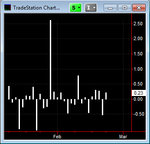DionysusToast
Legendary member
- Messages
- 5,965
- Likes
- 1,501
Sorry, but I only help those who are able to help themselves, and others.
Should you care to partake, and advance the learning of the students a bit more, we also now require an explanation of this next graph. I know DT will get it with his fancy TS programming, but it is also very simple to get it with excel (as simple as Charlton's post) and we can use the vast experience of the MSFT programmers, for free.
As I keep saying, this is all basic stuff, as some posters have rightly pointed out. However, it is the basics that matter most, in any job.

Hmmmm... I'm struggling without the symbol. I would say that based on the above
chart, bar number 17 represents a day that had at least one of :
- earnings release
- broker upgrade
- major news release
- company issuing new guidance



